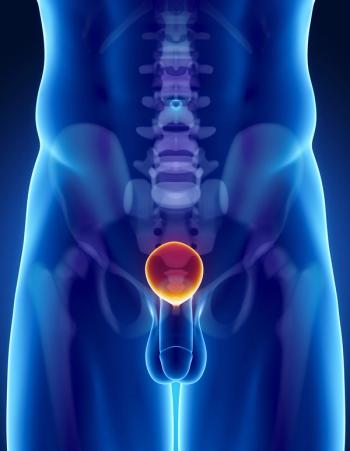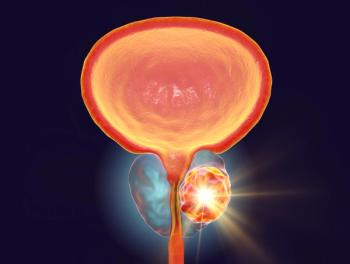
Durvalumab/Radiotherapy May Show Viability in Chemo-Ineligible NSCLC
The safety profile of durvalumab after radiotherapy was consistent with durvalumab after chemoradiotherapy among those with unresectable stage III NSCLC.
Durvalumab (Imfinzi) following definitive or palliative radiotherapy may be a viable option, as the combination exhibited encouraging efficacy and consistent tolerability for older patients or those with more frailty with unresectable stage III non–small cell lung cancer (NSCLC) not eligible for chemotherapy, according to findings from the single-arm phase 2 DUART study (NCT04249362) published in EMSO Open.
Among patients treated with the radiotherapy-based durvalumab regimen (n = 102), 97.1% had at least 1 any-grade adverse effect (AE), the most frequent of which included cough (20.6%), asthenia (20.6%), anemia (18.6%), dyspnea (18.6%), and pyrexia (16.7%). Additionally, grade 3 or 4 AEs were reported in 40.2% of patients, with the most common including pneumonia (4.9%), cardiac failure (3.9%), anemia, dyspnea, and hepatotoxicity (2.9% each).
AEs leading to treatment interruption occurred in 47.1% of patients, and AEs associated with discontinuation occurred in 21.6%. The most common AEs leading to interruption were cardiac failure, COVID-19 infection, and pneumonitis (4.9% each); those leading to discontinuation were pneumonitis (4.9%) and pneumonia (2.0%). Serious AEs occurred in 40.2%, of which 6.9% were fatal; 2 patients died due to unknown cause, with single incidences of fatal cardiac failure, cerebral ischemia, pneumonitis, pulmonary embolism, and pulmonary hemorrhage observed.
The confirmed objective response rate (ORR) among this patient population was numerically higher among those treated with definitive radiotherapy vs palliative radiotherapy at 34.0% (95% CI, 21.5%-48.3%) vs 24.5% (95% CI, 13.3%-38.9%), respectively. Additionally, 5.7% and 8.2% of the respective cohorts had unconfirmed responses. The only 2 complete responses were observed with definitive radiotherapy, and the median duration of response (DOR) was 56.9 weeks (95% CI, 31.0-not calculable [NC]) vs 34.1 weeks (95% CI, 24.3-NC) with palliative radiotherapy.
After a median follow-up of 11.1 months (range, < 0.1-33.2), the median progression-free survival (PFS) was 9.2 months (95% CI, 7.4-11.9) across all patients treated with durvalumab and the 12-month rate was 39.6% (95% CI, 29.3%-49.8%). Furthermore, after a median follow-up of 16.4 months (range, 0.9-33.4) for overall survival (OS), the median OS was 21.1 months (95% CI, 14.8-NC), with a 12-month rate of 64.7% (95% CI, 54.2%-73.3%). Survival outcomes generally favored those who received definitive radiotherapy, with a median PFS of 10.3 months (95% CI, 7.5-16.6) vs 7.6 months (95% CI, 5.6-11.0) with palliative radiotherapy and a median OS of 21.1 months (95% CI, 11.6-NC) vs 16.8 months (95% CI, 10.6-NC).
“The incidence of grade [3 or higher] AEs in DUART was lower than that reported in other previous studies where durvalumab was administered concurrently with definitive [radiotherapy],” Andrea R. Filippi, MD, professor in the Department of Radiation Oncology at the Istituto Nazionale dei Tumori in Milan, Italy, wrote in the publication with study coinvestigators. “The combination of [radiotherapy] with durvalumab may achieve complete molecular remission (based on ctDNA [circulating tumor DNA]) in some patients, even in patients treated with palliative [radiotherapy], suggesting for the first time that a selected group from this population could be cured without [chemotherapy], opening the door to new study designs based on ctDNA status.”
Patients in the phase 2 study were 18 years or older with histologically or cytologically confirmed, locally advanced, unresectable stage III NSCLC and were ineligible for chemotherapy per investigator assessment. Patients also had to express no evidence of disease progression following radiotherapy, which must have been completed within 6 weeks before durvalumab dosing. Additionally, patients had no prior immunotherapy and had an ECOG performance status of 0 to 2.
Those enrolled were placed in parallel cohorts based on radiation dose received prior to enrollment, with cohort A (n = 53) consisting of those who had undergone definitive radiotherapy vs cohort B (n = 49) consisting of those who had undergone palliative radiotherapy. Definitive radiotherapy comprised 60 Gy with or without 10% or more equivalent biologically effective dose (BED), and palliative radiotherapy comprised 40 to 54 Gy or equivalent BED. Durvalumab was given intravenously at 1500 mg every 4 weeks for 12 months in the absence of disease progression per RECIST v1.1 criteria, unacceptable toxicity, or withdrawal of consent.
Across both cohorts, the median age was 79.0 years (range, 43-87), with 64.7% of patients being 75 years or older. Patients were primarily men (71.6%), White (98.9%), and former smokers (67.6%) with an ECOG performance status of 1 (73.3%). Additionally, most patients had stage IIIA disease (60.8%), squamous cell histology (55.9%), and a PD-L1 expression of 1% or greater (53.5%).
The primary end point of the trial was safety and tolerability of durvalumab per investigator assessment within 6 months of initiation. Secondary end points included PFS, OS, ORR, DOR, and lung cancer–specific survival.
Reference
Filippi AR, García Campelo MR, Paoli JB, et al. Durvalumab after radiotherapy in patients with unresectable stage III non-small-cell lung cancer ineligible for chemotherapy: the DUART phase II nonrandomized controlled study. ESMO Open. 2025;10(9):105560. doi:10.1016/j.esmoop.2025.105560
Newsletter
Stay up to date on recent advances in the multidisciplinary approach to cancer.


















































































